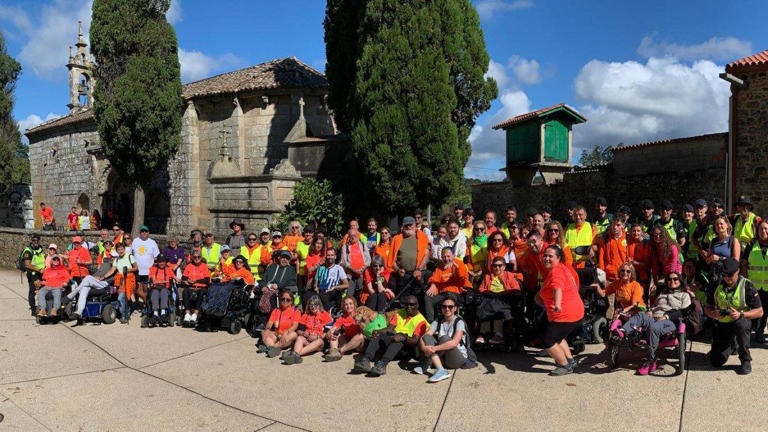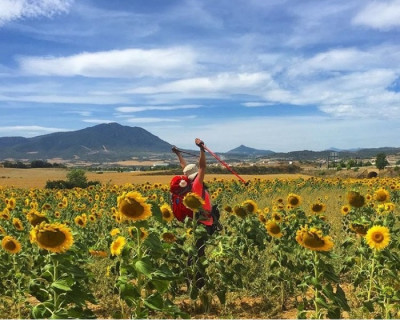3 ways to plan a Camino de Santiago pilgrimage
Escrito por Ernesto Diaz el 26 de julio de 2023
To begin at the end: the remains of the apostle Saint James (or Sant Iago, in Spanish) are believed to repose in an urn, in a tomb, in a crypt, in the looming medieval cathedral of the city named after him. Santiago de Compostela was built around the saint’s burial site, as revealed to a shepherd by a guiding star almost a millennium after the body was carried here by stone boat from Jerusalem, with angels guiding the way. Or so the story goes. It has since led more than 1,000 years’ worth of pilgrims to this convergence point of myth and history, via the network of cross-country trails known as the Camino de Santiago. In 2022, a record 438,000 people completed one of those routes, some of them covering only the final 62 miles (or 124 miles for cyclists) required to qualify for the official pilgrim certificate, the Compostela. It’s a measure of how popular the pilgrimage has become, drawing not just the Catholic faithful but recreational trekkers, mountain bikers, group tours and solo travellers, coming to work off their worries — or a few extra pounds — in the wilds of the Iberian peninsula.

There are seven main caminos (ways) and while they all end in Santiago de Compostela, they’re not all confined to Spain. The French Way, from the foothills of the Pyrenees, has some of the best infrastructure and is by far the busiest. Lesser-travelled alternatives, meanwhile, trace the Portuguese coast, the Cantabrian Mountains and the inland plains of Castile and León. Each route offers its own distinct pleasures in terms of climate, landscape, physical challenges and regional cultures. But there are recurring features, with all paths marked by holy ruins, shrines, monasteries and albergues (simple hostels that have served the routes since the Middle Ages). There’s always camaraderie among the wayfarers. A bottle of water or wine shared with strangers in the ruins of a hilltop hospital built for early pilgrims might be the defining moment of your trip. There’s also solitude, if that’s what you want, and the profound satisfaction of moving through all this natural beauty under your own steam. If you don’t find God, or even yourself, on the way, there is at least the promise of deep peace and quiet.
Days 1-3
With its Romanesque facade and ethereal blue azulejo tiling, Porto Cathedral makes for an eye-catching starting point. Divert to Matosinhos and follow the ocean along wooden walkways through landscapes of dunes, flowers and market gardens. Browse for lace in the old naval town of Vila do Conde, sample cod in 18th-century fishing port Póvoa de Varzim and watch kitesurfers off the protected shores of Esposende, en route towards Marinhas in far northern Portugal.
Days 4-7
This stretch turns from the sea to follow the Neiva River inland on a long, stone pathway. A magnificent iron bridge by Gustav Eiffel takes travellers over the Lima River into Viana do Castelo, where a funicular ascends to the Templo do Sagrado Coração de Jesus (‘Temple of the Sacred Heart of Jesus’), reminiscent of Paris’s Sacré Coeur. The path winds upward into eucalyptus forest, then back down to the ocean, passing coastal bastions and windmills to reach yet another river, the Minho, where a ferry crosses into Spain. On the far bank is A Guarda, famous for its lobster and for its ruins of an ancient Celtic shrine. Finish on the coast in Mougás.
Days 8-11
Further up the coast is the Royal Monastery of Santa María de Oia, once defended from attacking Turkish ships by Cistercian monks handy with cannons. The route here is nicknamed the Monastic Way in their honour. It weaves across to Baiona, the port that received first word of the New World from the returning ship La Pinta in 1493. Soak up the sea views, across floating mussel farms and the misty Cíes Islands in the Vigo estuary, before turning inland to join the classic Portuguese Way. Stop for oysters in the village of Arcade, then cross Ponte Sampaio bridge to the former Roman road that leads to Pontevedra.
Days 12-14
Pontevedra’s historic centre is worth exploring before the last push. Wander the gothic basilica of Santa María la Mayor and the Santo Domingo convent ruins before crossing bucolic Galician farmlands toward Caldas. Soak tired bones in thermal springs and refuel with a lamprey-filled empanada, then carry on to Padrón, the river port where the disciples are said to have first brought the body of Saint James. The end of this route follows the footsteps of Bishop Teodomiro, who found those remains some 900 years later and brought them to the resting place now known as Santiago de Compostela.
FUENTE: NATIONAL GEOGRAFHIC






